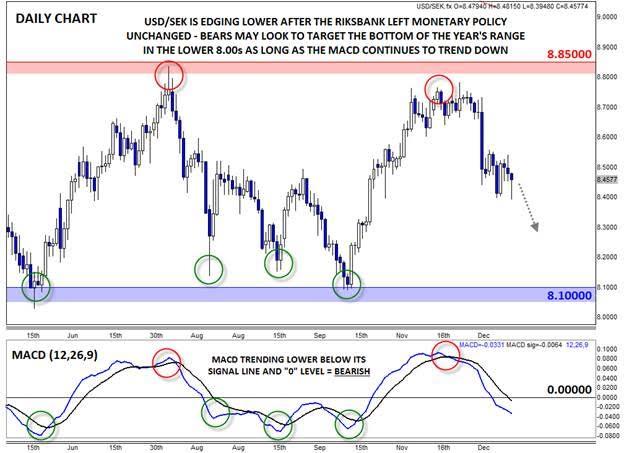![]()
Markets have been relatively quiet so far today with traders primarily adjusting their positions modestly ahead of tomorrow’s highly-anticipated Fed meeting (stay tuned for our full FOMC preview this afternoon).
However, there was one other second-tier central bank in action today: Sweden’s Riksbank. Much like the Swiss National Bank, Riksbank policymakers no doubt breathed a big sigh of relief when the European Central Bank opted for more tentative easing measures two weeks ago, as the half-hearted actions by the region’s behemoth central bank lessened the pressure on its smaller rivals to follow suit.
The Riksbank stuck to the script in today’s meeting, leaving its main repo rate at 0.35% and refraining from expanding its current SEK 200B bond buying program in a unanimous decision. Some market participants were anticipating a modest interest rate cut or expansion of the bank’s quantitative easing program, and the krona has rallied as these traders abandoned their short positions.
Before SEK bulls get too carried away however, it’s worth noting that the Riksbank did include a bit of an “escape clause” in its accompanying statement. Specifically, the world’s oldest central bank explicitly noted that it was “highly prepared” to ease monetary policy even between its scheduled monetary policy meetings. In other words, Sweden’s economy remains vulnerable to any lurches lower in the Eurozone economy, so the Riksbank is at great pains to prevent any unnecessary strength in the krona.
Technical View: USD/SEK
As we noted above, the SEK immediately strengthened in the wake of the release, but that initial burst higher is already starting to fade on the back of the dovish commentary. USD/SEK remains almost perfectly centered in the 8.10-8.85 range that has contained rates for almost the entire year thus far.
It is worth noting that the daily MACD indicator has rolled over a couple of weeks ago and recently crossed back below the “0” level; previous turning points in this indicator have marked significant tops and bottoms in USD/SEK for months. Therefore, rangebound traders may consider looking for more weakness toward the bottom of the range in the lower 8.00s as long as the MACD continues to trend lower.
This research is for informational purposes and should not be construed as personal advice. Trading any financial market involves risk. Trading on leverage involves risk of losses greater than deposits.
Recommended Content
Editors’ Picks
AUD/USD could extend the recovery to 0.6500 and above

The enhanced risk appetite and the weakening of the Greenback enabled AUD/USD to build on the promising start to the week and trade closer to the key barrier at 0.6500 the figure ahead of key inflation figures in Australia.
EUR/USD now refocuses on the 200-day SMA

EUR/USD extended its positive momentum and rose above the 1.0700 yardstick, driven by the intense PMI-led retracement in the US Dollar as well as a prevailing risk-friendly environment in the FX universe.
Gold struggles around $2,325 despite broad US Dollar’s weakness

Gold reversed its direction and rose to the $2,320 area, erasing a large portion of its daily losses in the process. The benchmark 10-year US Treasury bond yield stays in the red below 4.6% following the weak US PMI data and supports XAU/USD.
Bitcoin price makes run for previous cycle highs as Morgan Stanley pushes BTC ETF exposure

Bitcoin (BTC) price strength continues to grow, three days after the fourth halving. Optimism continues to abound in the market as Bitcoiners envision a reclamation of previous cycle highs.
US versus the Eurozone: Inflation divergence causes monetary desynchronization

Historically there is a very close correlation between changes in US Treasury yields and German Bund yields. This is relevant at the current juncture, considering that the recent hawkish twist in the tone of the Federal Reserve might continue to push US long-term interest rates higher and put upward pressure on bond yields in the Eurozone.
